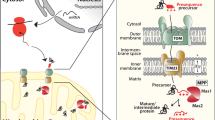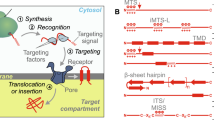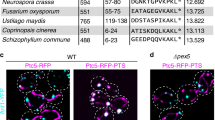Abstract
Targeting signals of mitochondrial precursors are cleaved in the matrix during or after import by the mitochondrial processing peptidase (MPP). This enzyme consists of two nonidenticalα- andβ-subunits each of molecular weight of about 50 kDa. In mammals and fungi, MPP is soluble in the matrix, whereas in plants the enzyme is part of the cytochromebc 1 complex. MPP is a metalloendopeptidase which has been classified as a member of the pitrilysin family on the basis of the HXXEHX76E zinc-binding motif present inβ-MPP. Both subunits of MPP are required for processing activity. Theα-subunit of MPP, which probably recognizes a three-dimensional motif adopted by the presequence, presents the presequence toβ-MPP, which carries the catalytic active site. MPP acts as an endoprotease on chemically synthesized peptides corresponding to mitochondrial presequences. Matrix-targeting signals and MPP cleavage signals seem to be distinct, although the two signals may overlap within a given presequence. The structural element helix-turn-helix, that cleavable presequences adopt in a membrane mimetic environment, may be required for processing but is not sufficient for proteolysis. Binding of the presequence byα-MPP tolerates a high degree of mutations of the presequence.α-MPP may present a degenerated cleavage site motif toβ-MPP in an accessible conformation for processing. The conformation of mitochondrial presequences bound to MPP remains largely unknown.
Similar content being viewed by others
References
Verner K. and Schatz G. (1988) Protein translocation across membranes. Science241: 1307–1313
Böhni P., Gasser S., Leaver C. and Schatz G. (1980) A matrix-localized mitochondrial protease processing cytoplasmically-made precursors to mitochondrial proteins. In: The Organization and Expression of the Mitochondrial Genome, pp. 423–433, Kroon A. M. and Saccone C. (eds), Elsevier/North Holland, Amsterdam
Böhni P. C., Daum G. and Schatz G. (1983) Import of proteins into mitochondria. Partial purification of a matrix-located protease involved in cleavage of mitochondria precursor polypeptides. J. Biol. Chem.258: 4937–4943
McAda P. and Douglas M. G. (1982) A neutral metallo-endoprotease involved in the processing of an F1-ATPase subunit precursor in mitochondria. J. Biol. Chem.257: 3177–3182
Miura S., Mori M. and Tatibana M. (1982) A mitochondrial protease that cleaves the precursor of ornithine carbamyltransferase precursor into mitochondria: purification and properties. Eur. J. Biochem.122: 641–647
Conboy J. G., Fenton W. A. and Rosenberg L. E. (1982) Processing of preornithine transcarbamylase requires a zinc-dependent protease localized to the mitochondrial matrix. Biochem. Biophys. Res. Commun.105: 1–7
Schmidt B., Wachter E., Sebald W., and Neupert W. (1984) Processing peptidase of neurospora mitochondria: two-step cleavage of imported ATPase subunit 9. Eur. J. Biochem.144: 581–588
Kumamoto T., Ito A. and Omura T. (1986) Characterization of a mitochondrial matrix protease catalysing the processing of adrenotoxin precursor. J. Biochem.100: 247–254
Hawlitschek G. H., Schneider H., Schmidt B., Tropschug, M., Hartl F. U. and Neupert W. (1988) Mitochondrial protein import: identification of processing peptidase and of PEP, a processing enhancing protein. Cell53: 795–806
Yang M., Jensen R. E. and Schatz G. (1988) Import of proteins into yeast mitochondria: the purified matrix protease contains two subunits which are encoded by the nuclear MAS1 and MAS2 genes. EMBO J.7: 3857–3862
Ou W. J., Ito A., Okazaki H. and Omura T. (1989) Purification and characterization of a processing protease from rat liver mitochondria. EMBO J8: 2605–2612
Kleiber J. Kalousek F., Swaroop M. and Rosenberg L. E. (1990) The general mitochondrial matrix processing protease from rat liver: structural characterization of the catalytic subunit. Proc. Natl. Acad. Sci. USA87: 7978–7982
Schulte U., Arretz M., Schneider H., Tropschug M., Wachter E., Neupert W. et al. (1989) A family of mitochondrial proteins involved in bioenergetics an biogenesis. Nature339: 147–149
Braun H. P., Emmermann M., Kruft V. and Schmitz U. K. (1992) The general mitochondrial processing peptidase from potato is an integral part of cytochrome c reductase of the respiratory chain. EMBO J.11: 3219–3227
Eriksson A. C. and Galser E. (1992) Mitochondrial processing peptidase: a general processing peptidase of spinach leaf mitochondria is a membrane-bound enzyme. Biochim. Biophys. Acta1140: 208–214
Emmerman M., Braun H. P. and Schmitz U. K. (1993) The two high molecular weight subunits of cytochrome c reductase from potato are immunologically related to the mitochondrial processing enhancing protein. Biochim. Biophys. Acta1142: 306–310
Emmermann M., Braun H. P. and Schmitz U. K. (1994) The mitochondrial processing peptidase from potato: a self-processing enzyme encoded by two differentially expressed genes. Mol. Gen. Genet.245: 237–245
Eriksson A. C., Sjöling S. and Galser E. (1993) A general processing proteinase of spinach leaf mitochondria is associated with thebc 1 complex of the respiratory chain. In: Plant mitochondria, pp. 299–306, Brennicke A. and Kück U. (eds), VCH Weinheim, New York
Yaffe M. P. and Schatz G. (1984) Two nuclear mutations that block mitochondrial protein import in yeast. Proc. Natl. Acad. Sci. USA.81: 4819–4823
Yaffe M. P., Ohta S. and Schatz G. (1985) A yeast mutant temperature-sensitive for mitochondrial assembly is deficient in a mitochondrial protease activity that cleaves imported precursor polypeptides. EMBO J.4: 2069–2074
Witte C., Jensen R. E., Yaffe M. P. and Schatz G. (1988) MAS1, a gene essential for yeast mitochondrial assembly, encodes a subunit of the mitochondrial processing protease. EMBO J.7: 1439–1447
Jensen R. E. and Yaffe M. P. (1988) Import of proteins into yeast mitochondria: the nuclear MAS2 gene encodes a component of the processing protease that is homologous to the MAS1-encoded subunit. EMBO J.7: 3863–3871
Pollock R. A., Hartl F.-U., Cheng M. Y., Ostermann J., Horwich A. and Neupert W. (1988) The processing peptidase of yeast mitochondria: the two cooperating components MPP and PEP are structurally related. EMBO J.7: 3493–3500
Emmermann M., Braun H. P., Arretz M. and Schmitz U. K. (1993) Characterization of the bifunctional cytochrome c reductase-processing peptidase complex from potato mitochondria. J. Biol. Chem.268: 18936–18942
Paces V., Rosenberg L. E., Fenton W. A. and Kalousek, F. (1993) Theβ subunit of the mitochondrial processing peptidase from rat liver: cloning and sequencing of a cDNA and comparison with a proposed family of metallopeptidases. Proc. Natl. Acad. Sci. USA.90: 5355–5358
Géli V., Yang M., Suda K., Lustig A. and Schatz G. (1990) The MAS-encoded processing protease of yeast mitochondria: overproduction and characterization of its two nonidentical subunits. J. Biol. Chem.265: 19216–19222
Hurt E. C., Allison D. S., Muller U. and Schatz G. (1987) Amino-terminal deletions in the presequence of an imported mitochondrial protein block the targeting function and proteolytic cleavage of the presequence at the carboxy terminus. J. Biol. Chem.262: 1420–1424
Kraus J. P., Novotny, J., Kalousek F., Swaroop M. and Rosenberg L. E. (1988) Different structures in the amino-terminal domain of the ornithine transcarbamylase leader peptide are involved in mitochondrial import and carboxyl-terminal cleavage. Proc. Natl. Acad. Sci. USA85: 8905–8909
Isaya G., Kalousek F., Fenton W. A. and Rosenberg L. E. (1991) Cleavage of precursors by the mitochondrial processing peptidase requires a compatible mature protein or an intermediate octapeptide. J. Cell Biol.113: 65–76
Schneider H., Arretz M., Wachter E. and Neupert W. (1990) Matrix processing peptidase of mitochondria: structure-function relationships. J. Biol. Chem.265: 9881–9887
Rawlings N. D. and Barrett A. J. (1991) Homologues of insulinase, a new superfamily of metalloendopeptidases. Biochem. J.275: 389–391
Rawlings N. D. and Barrett A. J. (1993) Evolutionary families of peptidases. Biochem. J.290: 205–218
Luciano P., Geoffroy S., Brandt A., Hernandez J. F. and Géli V. (1996) Theα-subunit of the yeast mitochondrial processing peptidase presents mitochondrial presequences to the catalyticβ-subunit. (Submitted for publication.)
Yang M., Géli, V., Oppliger W., Suda K., James P. and Schatz G. (1991) The MAS-encoded processing protease of yeast mitochondria: interaction of the purified enzyme with signal peptides and a purified precursor protein. J. Biol. Chem.266: 6416–6423
Arretz M., Schneider H., Guiard B., Brunner M. and Neupert W. (1994) Characterization of the mitochondrial processing peptidase ofNeurospora crassa. J. Biol. Chem.269: 4959–4967
Géli V. (1993) Functional reconstitution inEscherichia coli of the yeast mitochondrial matrix peptidase from its two inactive subunits. Proc. Natl. Acad. Sci. USA.90: 6247–6251
Saavedra-Alanis V. M., Rysavy P., Rosenberg L. E. and Kalousek F. (1994) Rat liver mitochondrial processing peptidase. Both alpha- and beta-subunits are required for activity. J. Biol. Chem.269: 9284–9288
Meulenberg J. J., Sellink E., Loenen W. A., Riegman N. H., van Kleef M. and Postma P. W. (1990) Cloning ofKlebsiella pneumoniae pqq genes and PQQ biosynthesis inEscherichia coli. FEMS Microbiol. Lett.59: 337–343
Pierotti A. R., Prat A., Chesneau V., Gaudoux F., Leseney A. M., Foulon T. et al. (1994)N-arginine dibasic convertase, a metalloendopeptidase as a prototype of a class of processing enzymes. Proc. Natl. Acad. Sci. USA91: 6078–6082
Braun H. P. and Schmitz U. K. (1995) Are the ‘core’ proteins of the mitochondrial bcl complex evolutionary relics of a processing protease? Trends Biochem. Sci.20: 171–175
Kuo W. L., Gehm B. D. and Rosner M. R. (1991) Regulation of insulin degradation: expression of an evolutionarily conserved insulin-degrading enzyme increases degradation via an intracellular pathway. Mol. Endocrinol.5: 1467–1476
Becker A. B. and Roth R. A. (1992) An unusual active site identified in a family of zinc metalloendopeptidases. Proc. Natl. Acad. Sci. USA89: 3835–3839
Matthews B. W. (1988) Structural basis of the action of thermolysin and related zinc peptidases. Accounts. Chem. Res.21: 333–340
Stocker W. and Bode W. (1995) Structural features of a superfamily of zinc-endopeptidases: the metzincins. Curr. Opin. Struct. Biol.5: 383–390
Becker A. B. and Roth R. A. (1993) Identification of glutamate-169 as the third zinc-binding residue in proteinase III, a member of the family of insulin-degrading enzymes. Biochem. J.292: 137–142
Perlman R. K., Gehm B. D., Kuo W. L. and Rosner M. R. (1993) Functional analysis of conserved residues in the active site of insulin-degrading enzyme. J. Biol. Chem.268: 21538–21544
Kitada S., Shimokata K., Niidome T., Ogishima T. and Ito A (1995) A putative metal-binding site in the beta subunit of rat mitochondrial processing peptidase is essential for its catalytic activity. J. Biochem.117: 1148–1150
Cheng Y. S. E. and Zipser D. (1979) Purification and characterization of protease III fromEscherichia coli. J. Biol. Chem.254: 4698–4706
Ebrahim A., Hamel F. G., Bennett R. G. and Duckworth W. C. (1991) Identification of the metal associated with the insulin degrading enzyme. Biochem. Biophys. Res. Commun.181: 1398–1406
Ding L., Becker A. B., Suzuki A. and Roth R. A. (1992) Comparison of the enzymatic and biochemical properties of human insulin-degrading enzyme andEscherichia coli protease III. J. Biol. Chem.267: 2414–2420
Lemire B. D., Fankhauser C., Baker A. and Schatz G. (1989) The mitochondrial targeting function of randomly generated peptide sequences correlates with predicted helical amphiphilicity. J. Biol. Chem.264: 20206–20215
Allison D. S. and Schatz G. (1986) Artificial mitochondrial presequences. Proc. Natl. Acad. Sci. USA83: 9011–9015
Roise D., Theiler F., Horvath S. J., Tomich J. M., Richards J. H., Allison D. S. et al. (1988) Amphiphilicity is essential for mitochondrial presequence function. EMBO J.7: 649–653
Roise D., Horvath S. J., Tomich J. M., Richards J. H. and Schatz G. (1986) A chemically synthesized pre-sequence of an imported mitochondrial protein can form an amphiphilic helix and perturb natural and artificial phospholipid bilayers. EMBO J.5: 1327–1334
Von Heijne G. (1986) Mitochondrial targeting sequences may form amphiphilic helices. EMBO J.5: 1335–1342
Gavel Y. and von Heijne G. (1990) Cleavage-site motifs in mitochondrial targeting peptides. Prot. Engineer.4: 33–37
Niidome T., Kitada S., Shimokata K., Ogishima T. and Ito A. (1994) Arginine residues in the extension peptide are required for cleavage of a precursor by mitochondrial processing peptidase: demonstration using synthetic peptide as a substrate. J. Biol. Chem.269: 24719–24722
Endo T., Shimada I., Roise D. and Inagaki F. (1989) N-terminal half of a mitochondrial presequence peptide takes a helical conformation when bound to dodecylphosphocholine micelles —a proton magnetic resonance study. J. Biochem.106: 396–400
Chupin V., Leenhouts J. M., de Kroon A. I. P. M. and de Kruijff B. (1995) Cardiolipin modulates the secondary structure of the presequence peptide of cytochrome oxidase subunit IV: a 2D1H-NMR study. FEBS Lett.373: 239–244
Chupin V., Leenhouts J. M., de Kroon A. I. P. M. and de Kruijff B. (1995) Secondary structure and topology of a mitochondrial presequence peptide associated with negatively charged micelles. A 2D1H-NMR study. Biochemistry35: 3141–3146
Bruch M. D. and Hoyt D. W. (1992) Conformational analysis of a mitochondrial presequence derived from the F1-ATPase beta-subunit by CD and NMR spectroscopy. Biochim. Biophys. Acta1159: 81–93
Karslake C., Piotto M. E., Pak Y. K., Weiner H. and Gorenstein D. G. (1990) 2D NMR and structural model for a mitochondrial signal peptide bound to a micelle. Biochemistry29: 9872–9878
Wang Y. and Weiner H. (1993) The presequence of rat liver aldehyde dehydrogenase requires the presence of an alphahelix at its N-terminal region which is stabilized by the helix at its C termini. J. Biol. Chem.268: 4759–4765
Thornton K., Wang Y., Weiner H. and Gorenstein D. G. (1993) Import, processing, and two-dimensional NMR structure of a linker-deleted signal peptide of rat liver mitochondrial aldhehyde. J. Biol. Chem.268: 19906–19914
Hammen P. K., Gorenstein D. G. and Weiner H. (1994) Structure of the signal sequences for two mitochondrial matrix proteins that are not proteolytically processed upon import. Biochemistry33: 8610–8617
Srinivasan M., Kalousek F., Farrell L. and Curthoys N. P. (1995) Role of the N-terminal 118 amino acids in the processing of the rat renal mitochondrial glutaminase precursor. J. Biol. Chem.270: 1191–1197
Waltner M. and Weiner H. (1995) Conversion of a nonprocessed mitochondrial precursor protein into one that is processed by the mitochondrial processing peptidase. J. Biol. Chem.270: 26311–26317
Ou W. J., Kumamoto T., Mihara K., Kitada S., Niidome T., Ito A. and Omura T. (1994) Structural requirements for recognition of the precursor proteins by the mitochondrial processing peptidase. J. Biol. Chem.269: 24673–24678
Jarvis J. A., Ryan M. T., Hoogenraad N. J., Craik D. J. and Hoj P. B. (1995) Solution structure of the acetylated and noncleavable mitochondrial targeting signal of rat chaperonin 10. J. Biol. Chem.270: 1323–1331
Klaus C., Guiard B., Neupert W. and Brunner M. (1996) Determinants in the presequence of cytochromeb2 for import into mitochondria and for proteolytic processing. Eur. J. Biochem.236: 856–861
Author information
Authors and Affiliations
Corresponding author
Rights and permissions
About this article
Cite this article
Luciano, P., Géli, V. The mitochondrial processing peptidase: Function and specificity. Experientia 52, 1077–1082 (1996). https://doi.org/10.1007/BF01952105
Issue Date:
DOI: https://doi.org/10.1007/BF01952105




